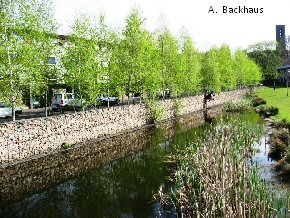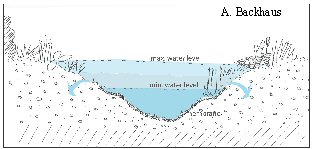Wet basins
Wet basins (ponds, retention basins) are basins that have a permanent pool of water and are designed to accumulate rainwater from an adjacent impervious area and then slowly release the water after rainfall. The water level of wet basins therefore varies (see figure 2). The water disappears, either by infiltration into a neighbouring area or by a sunken drain into a sewer or stream. The temporary storage of the water in the basin and the permanent water volume allow pollution particles to form sediment. The extent of sedimentation depends on such factors as the length of time the water is in the basin, turbulence in the basin and the size and weight of the particles. Natural lakes are often used as wet basins, but basins resembling natural lakes are also excavated. The lake must be dug out to a depth that establishes contact with the groundwater or a membrane must be installed.

Figure 1: Wet basin in a residential area (Photo: A. Backhaus)

Figure 2: The characteristically fluctuating water levels in a wet basin (Sketch: A. Backhaus)

